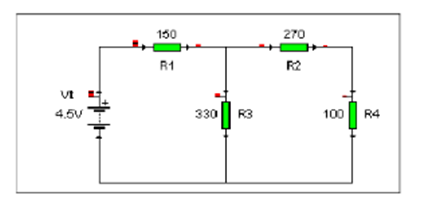Diferencia entre revisiones de «1soin/ECA/UD2/02 Ariketa. Laborategiko Praktika II (ZIRKUITOAK)»
| Línea 53: | Línea 53: | ||
|} | |} | ||
'''2- Kalkulatu parametro berberak teorikoki eta konparatu itzazu lortutako balioekin. Azaldu | '''2- Kalkulatu parametro berberak teorikoki eta konparatu itzazu lortutako balioekin. Azaldu itzazu aldeak (baldin badaude).''' | ||
itzazu aldeak (baldin badaude).''' | |||
<math>R_{23} = 270+ 100= 370\Omega</math> | <math>R_{23} = 270+ 100= 370\Omega</math> | ||
Revisión del 09:21 30 nov 2016
POLIMETROAREN ERABILPENA
R1 (marroia-berdea-marroia), R2 (gorria-bioleta-marroia), R3 (laranja-laranja-marroia) y R4 (marroia-beltza-marroia) erresistentziak konekta itzazu ondoko eskemak adierazten duen gisa. Elikatu zirkuitua zuzeneko korrontearen sorgailua erabilita eta 4,5 V-ko tentsioa ezarri. Eskema elektrikoa:
1 - Polimetroa erabilita, hartu ondorengo neurriak eta idatzi lorturiko balioak beheko taulan:
a) Voltimetroa: VT, V1, V2, V3 eta V4. b) Amperimetroa: IT, I1 , I2, I3 eta I4. c) Ohmetroa: RT, R1, R2, R3 eta R4.
| VT (V) | V11 (V) | V2 (V) | V3 (V) | V4 (V) |
| 4,55 | 2,10 | 1,81 | 2,46 | 0,64 |
| IT (A) | I1 (A) | I2 (A) | I3 (A) | I4 (A) |
| 13,65 | 13,64 | 6,47 | 7,31 | 6,47 |
| RT ([math]\displaystyle{ \Omega }[/math]) | R1 ([math]\displaystyle{ \Omega }[/math]) | R2 ([math]\displaystyle{ \Omega }[/math]) | R3 ([math]\displaystyle{ \Omega }[/math]) | R4 ([math]\displaystyle{ \Omega }[/math]) |
| 323 | 148,7 | 328 | 274 | 98,3 |
2- Kalkulatu parametro berberak teorikoki eta konparatu itzazu lortutako balioekin. Azaldu itzazu aldeak (baldin badaude).
[math]\displaystyle{ R_{23} = 270+ 100= 370\Omega }[/math]
[math]\displaystyle{ R_{234} \Rightarrow \frac{1}{R_{234}} = \frac{1}{R_{23}} + \frac{1}{R_4} \Rightarrow \frac{1}{R_{234}} = \frac{1}{370} + \frac{1}{330} = \frac{7}{1221} \Rightarrow R_{234} = 174,42\Omega }[/math]
[math]\displaystyle{ R_T = 150+ 174,42 = 324,42\Omega }[/math]
[math]\displaystyle{ I = \frac{V}{R} \Rightarrow I = \frac{4,5}{324,42} = 0,013A }[/math]
[math]\displaystyle{ V_1 = I \cdot R_1 \Rightarrow V_1 = 0,013 \cdot 150= 1,95V }[/math]
[math]\displaystyle{ V_{234} = I \cdot R_{234} \Rightarrow V_{234} = 0,013 \cdot 174,42= 2,56V }[/math]
[math]\displaystyle{ I_{23} = \frac{V_{234}}{R_{23}} \Rightarrow I = \frac{2,55}{370} = 0,0068A }[/math]
[math]\displaystyle{ I_4 = \frac{V_{234}}{R_4} \Rightarrow I = \frac{2,55}{330} = 0,00772A }[/math]
[math]\displaystyle{ V_2 = I_{23} \cdot R_2 \Rightarrow V_2 = 0,0068 \cdot 270= 1,86V }[/math]
[math]\displaystyle{ V_3 = I_{23} \cdot R_3 \Rightarrow V_3 = 0,0068 \cdot 100= 0,68V }[/math]
